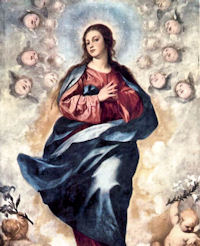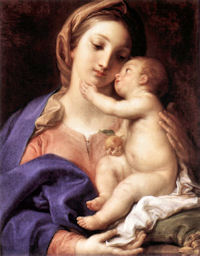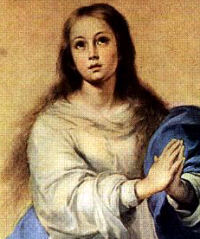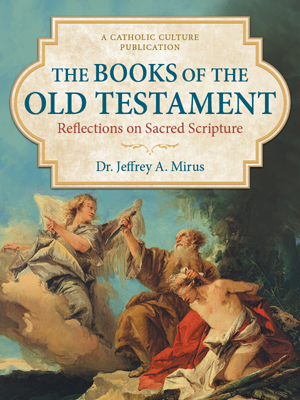Advent: December 8th
Solemnity of the Immaculate Conception of the Blessed Virgin Mary
» Enjoy our Liturgical Seasons series of e-books!
Today the Church celebrates the Solemnity of the Immaculate Conception, the solemn dogma defined by Blessed Pope Pius IX in 1854. As Our Lady Immaculately Conceived is the patroness of the United States of America, this is a holy day of obligation in the United States.
Through the centuries the Church has become ever more aware that Mary, "full of grace" through God, was redeemed from the moment of her conception. That is what the dogma of the Immaculate Conception confesses, as Blessed Pope Pius IX proclaimed on December 8, 1854: "The most Blessed Virgin Mary was, from the first moment of her conception, by a singular grace and privilege of almighty God and by virtue of the merits of Jesus Christ, Saviour of the human race, preserved immune from all stain of original sin." — Catechism of the Catholic Church
Commentary on the Mass Readings for the Solemnity of the Immaculate Conception
The First Reading is from the Book of Genesis 3:9-15, 20. The preceding verses (2:4--3:8) described the temptation of the woman (later called Eve) by the serpent. She succumbs and tempts the man. As soon as they had disobeyed God's command given in 2:16-17, they realized their guilt and tried to hide from God.
"I will put enmity between you and the woman and between your offspring and hers." These words of God addressed to the serpent, the evil tempter, immediately after the sin of disobedience committed by the first parents, have been called the proto-Evangelium or "first good news" of hope for the human race. These verses from the Book of Genesis have been chosen for today's feast day, that of the Immaculate Conception of Mary, because she was chosen by God to be the human Mother of his Incarnate Son, and was conceived free form any stain of the sin handed down from the first parents. From the first moment of her human existence she was "full of grace" and God's "highly favored daughter."
In Mary, therefore, this "first good news" had its first fulfillment. Satan had no part in her. The serpent had lost his power in her case. This was because of the privileged position God had allotted to her. She was to be the Mother of the long-expected Messiah—Savior, who would finally crush the serpent's head.
The Second Reading is from the Letter of St. Paul to the Ephesians 1:3-6; 11-12. From his prison in Rome (about 63 A.D.) St. Paul wrote this letter to his converts in Ephesus. The purpose of the letter was to recall to their minds the basic Christian truths and to encourage them to remain faithful followers of Christ. It is closely connected with the Feast of the Immaculate Conception which we are celebrating today. God planned from all eternity to make man, the masterpiece and master of creation, his adopted son, and heir to his own eternal happiness. He was to bring this about through his divine Son's adoption of our human nature. Man would then be a brother of Christ and therefore a son of God by adoption. Christ, the Son of God in human nature, the God-man, is the pivotal point in all of God's creative activity. In him, through him, and for him all creation came into existence. In him and through him all making, the whole human race, was destined for eternal life.
But man, realizing the many gifts which he had, and forgetting the one who gave them to him, grew proud of his own capabilities and wanted to be his own master. He rebelled and sin came into the world. It did not stop God from carrying out his eternal plan. The Incarnation still took place.
The Gospel is from Luke 1:26-38, a brief account of the Annunciation or the message of the Angel Gabriel to Mary. He told her that she was to be the Mother of the Messiah, Son of the Most High. When the angel solved the problem concerning her virginity, Mary humbly accepted the role that God had planned for her. At that moment of acceptance the Incarnation took place. The Son of God began his human life in the chaste womb of the Blessed Virgin.
Meditation: Immaculate Conception of Mary
"Hail Mary, full of grace." For thousands of years, millions of times per day the Virgin Mary is greeted by the faithful with the greeting of the Archangel, that we hear resonating anew in today’s Gospel. The sons of the Church learn from the words of the Archangel Gabriel that the fullness of the mystery of God’s grace was realized in Holy Mary. St Paul the Apostle teaches us that the Father made all fullness dwell in His Incarnate Son (c.f. Col 1:12-20), which overflows from Christ’s head and spills out on His Mystical Body that is the Church. Before descending in Body, Christ’s fullness was spread in a unique and unrepeatable way on Mary, predestined from eternity to be the Mother of God.
Significantly in the first reading, the liturgy recalls the figure of Eve, the mother of all the living. The Fathers of the Church saw in Mary, the new Eve that unties the knot bound by the first woman. The knot of disobedience tied by Eve, was untied by the obedience of Mary. As Eve was created in purity and integrity, also the new Eve was miraculously preserved from the contamination of original sin because she had to give humanity the Word, who was incarnated for our ransom.
Saint Irenaeus compares the virginity of the pure earth from which Adam was drawn to the virginity of the immaculate humanity of Mary from which the Second Adam was drawn. ‘And as the protoplast himself, Adam, had his substance from untilled and as yet virgin soil (for God had not yet sent rain, and man had not tilled the ground (Genesis 2:5) so did He who is the Word, recapitulating Adam in Himself, rightly receive a birth, enabling Him to gather up Adam [into Himself], from Mary, who was as yet a virgin’ (Adversus hereses III, 21:10).
 Blessed Pope Pius IX on the 8th of December 1854 proclaimed the Dogma of the faith revealed by God that the Blessed Virgin Mary "in the first instant of her conception, by a singular privilege and grace granted by God, in view of the merits of Jesus Christ, the Saviour of the human race, was preserved exempt from all stain of original sin" (Denz.-Schonm, 2083). If the official proclamation of the dogma is relatively recent, the profession of faith by Christians and the liturgy is very ancient in this regard. Furthermore, four years later the same Virgin Mary, appearing in Lourdes to St Bernadette, confirmed the truth of the doctrine by presenting herself with the title ‘I am the Immaculate Conception.’
Blessed Pope Pius IX on the 8th of December 1854 proclaimed the Dogma of the faith revealed by God that the Blessed Virgin Mary "in the first instant of her conception, by a singular privilege and grace granted by God, in view of the merits of Jesus Christ, the Saviour of the human race, was preserved exempt from all stain of original sin" (Denz.-Schonm, 2083). If the official proclamation of the dogma is relatively recent, the profession of faith by Christians and the liturgy is very ancient in this regard. Furthermore, four years later the same Virgin Mary, appearing in Lourdes to St Bernadette, confirmed the truth of the doctrine by presenting herself with the title ‘I am the Immaculate Conception.’
Mary’s predestination to this singular grace—consistent with the suspension of the universal decree by which every man, from the moment of his conception is contaminated with original sin—leads us to ponder in the deepest depths the mystery of the Most Holy Trinity’s salvific plan. God, One and Triune, had foreseen from the very beginning the future incarnation of the Word culminating in the redemption of human nature that had fallen into sin. He therefore predestined pure Mary, so that He could draw from her uncontaminated humanity, which the Son could adopt in order to re-establish in Himself the original purity of creation and reorientate it to eternal glory.
For this reason, in the second reading of today’s liturgy, St Paul reminds us that God wants to see us holy and immaculate before Him. The purity of our origins seemed to be irredeemably lost. However, in Immaculate Mary, God found the perfect solution to reverse the disaster made from the misuse of our liberty, and returned humanity to the original purity that seemed hopelessly lost.
Mary’s Immaculate Conception is a direct consequence of her Divine Maternity. St. Anselm of Aosta wrote: ‘Assuredly, it was fitting that the Virgin be beautified with a purity than which a greater cannot be conceived, except for God's. For, toward her, God the Father was so disposed to give His only Son who was naturally one and the same common Son of God the Father and of the Virgin.’ (De conceptu virginali et originali peccato, XVIII)
 This link between the privilege of Divine Maternity and Mary’s Immaculate Conception results also in her superiority with respect to us. She is a perfect image of the Church in heaven, the new triumphant Jerusalem, that won’t have any marks nor will there be pain and death. This is why today’s preface recites: '…she was to be a worthy mother of your Son, your sign of favour to the church at its beginning, and the promise of its perfection as the bride of Christ, radiant in beauty’. Also in heaven Mary is not and will never be only a disciple, but her Son’s most exalted. She is and will always be the Mother of God, the Mother of the Church, the Queen of the Angels and Saints. Therefore, the preface of the Mass adds: ‘…You chose her from all creatures to be our advocate with you and our pattern of holiness.’
This link between the privilege of Divine Maternity and Mary’s Immaculate Conception results also in her superiority with respect to us. She is a perfect image of the Church in heaven, the new triumphant Jerusalem, that won’t have any marks nor will there be pain and death. This is why today’s preface recites: '…she was to be a worthy mother of your Son, your sign of favour to the church at its beginning, and the promise of its perfection as the bride of Christ, radiant in beauty’. Also in heaven Mary is not and will never be only a disciple, but her Son’s most exalted. She is and will always be the Mother of God, the Mother of the Church, the Queen of the Angels and Saints. Therefore, the preface of the Mass adds: ‘…You chose her from all creatures to be our advocate with you and our pattern of holiness.’
Mary was Immaculate because she had to be the Mother of God. She, herself has received the original grace of purity and the final state of the blessed life that we also, by collaborating with Divine Grace, hope one day to receive.
Immaculate Mary is full of grace. She is not only Christ’s disciple, who with the help of grace has overcome the chains of sin, but she is totius Trinitatis nobile triclinium, the noble resting place of the Holy Trinity (St Thomas Aquinas, Exposito Salutationis Angelicae, I). The Immaculate, full of grace, will always be Mother and Queen for that elect part of the Church that we hope one day to join, that will one day joyfully sing before the Almighty.
—From the Dicastery for the Clergy
Patronage: United States; barrel makers; cloth makers; cloth workers; coopers; tapestry workers; upholsterers. See CatholicSaints.info for a long list of locations that claim Our Lady's patronage.
Symbols and Representation: crown and monogram; lily; enclosed garden; crown of stars; glass (symbol of purity) lily often placed in a vase of transparent glass; lily of the valley.
Highlights and Things to Do:
- The dogma of the Immaculate Conception lends itself to fruitful meditation and should be taught to children. The doctrine of original sin, the sin of Adam and its effects on the human race, is a good beginning for study. For the best explanation of the teachings of the Church on this, see the Catechism of the Catholic Church, numbers 386-412. Also, you might read the Apostolic Constitution The Immaculate Conception (Ineffabilis Deus) where Pope Pius IX defined ex cathedra the dogma of the Immaculate Conception of the Blessed Virgin Mary. The decree was promulgated on December 8, 1854, the date of the annual feast of the Immaculate Conception.
- Other readings from the Catholic Culture Library:
- Pope Pius IX's bull, Ubi Primum (On The Immaculate Conception) an encyclical of Pope Pius IX to the bishops of the Catholic Church asking them for opinion on the definition of a dogma on the Immaculate Conception of the Virgin Mary. It was issued on February 2, 1849;
- Ad Diem Illum Laetissimum (On The Immaculate Conception) by Pope Saint Pius X;
- Fulgens Corona (Proclaiming A Marian Year To Commemorate The Centenary Of The Definition Of The Dogma Of The Immaculate Conception) by Pope Pius XII;
- On Devotion to the Blessed Virgin Mary (Marialis Cultus) by Pope Saint Paul VI;
- Immaculate Conception Defined by Pius IX by Pope Saint John Paul II;
- John Duns Scotus: Champion of the Immaculate Conception by Brother John M. Samaha, S.M.;
- The Message of the Virgin of Lourdes by Bishop Donald Montrose, D.D.;
- The Immaculate Conception by Abbot Gueranger
- Mary as the Immaculate Conception is the patroness of the United States. Visit or take a virtual tour of the Basilica of the National Shrine of Our Lady of the Immaculate Conception, America's patronal church.
- This day would also be appropriate for parents to plan their approach on family sex education, as it is the privilege and duty of parents to teach their own children in this area.
- Make a Mary candle for the feast of the Immaculate Conception. See Celebrating for the Feast of the Immaculate Conception for details and other ideas.
- Prepare an all white meal for dinner and then discuss with your children the dogma of the Immaculate Conception with the visual aids of dinner showing the purity and the stainlessness of Mary's soul. Read Teaching the Immaculate Conception and Advent and the Immaculate Conception for discussion ideas.
- The special treat for this feast is Moravian Spritz, or gingerbread cookies, loaded with fine, aromatic spices. These are mixed on the vigil, December 7. Or make your favorite gingerbread cookie. Perhaps for this solemnity the family could make a gingerbread house or Gingerbread Bowls.
- See also Catholic Cuisine for other food ideas.
- Today, plant an Immaculate Conception Rose Bush. During this winter season, it is also a good time to plan a Mary Garden. Flower Theology by John Stokes, the website Mary's Gardens and the book Mary's Flowers, Gardens, Legends and Meditations by Mary's Gardens Associate, Vincenzina Krymow, are good beginnings for planning your garden.
- No room for a garden? No time to nurture nature? Read Flowers for the Fairest by Daniel Foley to read about flowers appropriate for Our Lady, and purchase a small bouquet or a few flowers...real or silk to display for feasts of Mary.
Ideas for dinner, with a theme of white for purity:
Appetizers: Crackers and white cheeses;
Soups: cream soups, such as clam chowder, potato soup, cream of celery;
Main Course: chicken breasts, pasta with Alfredo sauce;
Side Dishes: mashed potatoes, white rice, cauliflower with (or without) white cheese sauce, white bread (with crusts removed), white corn;
Dessert: White cake with white icing, meringue kisses, vanilla ice cream, whipped cream, white chocolate.






